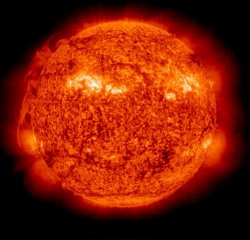Factors of global warming and climate change
 Scientists are studing how the Sun effects Earth’s climate. (This image was taken by instruments aboard NASA's SOHO spacecraft.)
Scientists are studing how the Sun effects Earth’s climate. (This image was taken by instruments aboard NASA's SOHO spacecraft.)
Credit: NASA
Herschel’s study didn’t make a big impact at the time because he did not have access to historical temperature records to make any useful comparisons. However, there has been a significant amount of research conducted since then to show that variations in the Sun's energy output have an impact on changes in Earth’s climate.
A research study published earlier this year in the Journal of Atmospheric and Solar-Terrestrial Physics provides more evidence of this link between the Sun and the Earth. Through their analysis of historic temperature deviations, geomagnetic activity and the frequency of sunspots, the authors concluded that “the Sun has a significant role to play in the long-term and short-term climate change.”
“With more and more data available, it may provoke some thought to further explore the solar influence on Earth's climate with geomagnetic activity acting as a possible link, ” said lead author Mufti Sabi ud din, scientist of the Astrophysical Sciences Division at the Bhabha Atomic Research Center in India's Department of Atomic Energy. “It may evoke some response so as to bring to the fore the substantial role of the natural forcing at work on the observed climate variability.”
Mufti, however, did note that the evidence of the Sun and other natural forces being the primary cause for climate change is still inadequate.
Pointing out the geopolitical sensitivity of the topic itself, Mufti was careful not to rule out anthropogenic effects.
 “We have made it amply clear that the anthropogenic origins cannot also be ruled out, ” Mufti said.
“We have made it amply clear that the anthropogenic origins cannot also be ruled out, ” Mufti said.
According to Schmidt, while the Sun does have some impact, it is definitively not the reason for current patterns of climate change.
“There is an effect, ” Schmidt said, “but it is hard to detect in surface records, and is certainly not responsible for recent trends.”
Orbital Change
Another natural occurrence that has caused major changes in the Earth's climate in the past is shifts in the Earth's orbit. Consider the Sahara desert, for example. There is a wide acceptance among scientists that the Sahara transformed from a fertile grassland to a desert because of a change to the Earth's orbit. This shift in how the Earth circled the Sun affected the amount of sunlight that region of Africa received.
The Earth's orbital tilt is said to vary between 22 and 25 degrees roughly every 41, 000 years. While a natural event such as this could bring about major changes to the climate, some scientists are warning that there is a possibility for reverse feedback. In other words, instead of an orbital tilt causing climate change, such as the one that took place in the African continent, current changes in climate could end up causing changes in the Earth's axial tilt.
In an article published late last year, Astrobiology Magazine reported on such a prediction: “Scientists from NASA's Jet Propulsion Laboratory say that the current melting of ice in Greenland is...


|
Climate Change: Factors Affecting Climate Change, How Climate Change Affects Peoples Lives, And Emergency Plans To Minimize The Effects Of Natural Disasters eBooks |